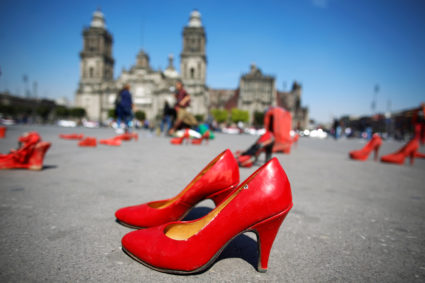
This artist's red shoes stand in for all the women lost to violence
Editor's note: This story contains graphic details of violence.
Elina Chauvet's red shoes are worldly. They've been in Milan, Italy, and Grand Rapids, Michigan. Not just one pair, but hundreds — red boots, red heels, red toddler shoes. They're not there to see the sights, but to take up space. Especially when the women or girls who would have worn them no longer take up any space, except in the lives of their loved ones.
For more than a decade, Chauvet has staged her "Los Zapatos Rojos" installation in cities around the world. In January, the 60-year-old Mexican artist helped activists paint 300 shoes red and laid them out in pairs in an open, public place: inside Mexico City's historic square. Some of the pairs — four of them — had once belonged to women who had been victims of gender-based deadly violence. To mark their absence, two mothers had personally painted and placed their daughters' shoes inside the plaza.
For Chauvet, red takes on several meanings. It represents bloodshed, but also change and hope and love, according to the artist.

On Monday, nearly two months since Chauvet's installation, Mexican activists launched a nationwide, 24-hour women's strike, known as #UnDiaSinNosotras (A Day Without Us) on social media. There were fewer women and girls in work places, schools, the streets and other public spaces to demonstrate what it would be like if there were no women. Activists hoped the action will further pressure government officials into taking action against femicide in the country.
Mexico officially made "femicides" — the killings of women because of their gender — legally distinct from homicides in 2012. That change was meant to lead to tougher penalties and a greater support system for victims.
On average, 10 women and girls are killed each day in Mexico, according to an oft-cited statistic. That number has risen since 2016, when official government figures put the number at eight per day. But not all female murder victims are classified as femicide — that can differ in each country according to their specific legal definition.

The Mexican government labels a killing as a femicide when there are certain "reasons" for the violence, including whether the victim suffered degrading injuries or mutilations before or after their death, if the victim's body is displayed in a public place, or if there's a history of violence in the family, workplace or at school against the victim.
Calls for widespread protests ramped up after a series of grisly killings. Ingrid Escamilla, 25, was found stabbed in Mexico City, her body skinned and missing several organs. Police said Escamilla's husband confessed to the killing. Photos of her body were then spread on social media and websites. One national newspaper, Pasala, ran its story of Escamilla's death with the headline: "It was Cupid's fault."
In a separate case, 7-year-old Fátima Cecilia Aldrighett was abducted from her school in Mexico City and later found dead in a plastic bag. Police found her body days after news of Escamilla's death.
Despite a 2012 claim by a Mexican delegation to the United Nations that the country was "gaining ground" on ending femicide in the country, the numbers have since continued to climb. The year 2019 was Mexico's most violent year overall in recent recorded history. Mexican officials recorded 35,558 homicides. Of those, 3,825 victims were women. And the number of killings that were investigated and classified as femicides is 1,006. The year before, that number was at 912.
The government's repeated statements to investigate and prosecute the cases have not been borne out. The number can vary, but fewer than 10 percent of femicide cases are solved.

Compared to other countries, the violence against women in Mexico "does not a reach the most extreme levels," a 2017 report from researchers at the University of San Diego said, but "it represents an intractable problem" that has been made more complicated, in part, by authorities' "half-hearted measures" to address the killings.
The report, co-written by lead author Michael Lettieri, found that the violence caused wider cultural damage than simply to the women who were murdered.
"Femicides terrify, denying women equal access to public space and opportunities, and further shredding a social fabric already torn by a decade-long drug war," the report said.
Lettieri told the PBS NewsHour that some of the underlying causes of femicide, including police re-victimizing people or policymakers' general disregard for the gender-based killings, are factors that ought to be addressed before it leads to impunity.
He also said Mexico has become a "global reference point" for examining femicides. Part of this was the media attention around the unsolved murders of women and girls in Ciudad Juárez during the 1990s and 2000s. But the problem is larger than Juárez, said Lettieri, who's now a fellow at University of California, San Diego's Center for U.S.-Mexican Studies.
Lettieri said, for Mexicans, Juarez isn't their reference point for femicide.
"They look around the corner," he said, referring to the violence that exists in their own communities.

Chauvet and other activists are quick to name what they believe is the largest hurdle to ending femicides: impunity, and a fractured response from the Mexican police and government. She said it's a "constant battle" for mothers to get their daughters' cases solved or investigated.
"It's getting worse … because the laws — even though they exist — they are not upheld by the government, the local authorities, the judges," Chauvet said. "It's a patriarchal system that protects the murderer and blames the victim."
Chauvet said she first put together the red shoes installation in 2009 after her sister was killed by her husband in a domestic violence case in Ciudad Juárez. Her sister was 32 years old.
"Her death was more than an inspiration," Chauvet said. "This was a way to take away the pain through the art."
The project is also "a direct message to the [Mexican] government," she said. "If it had given more attention to this issue years ago, these women would be with their families, at home right now."
Chauvet said she's seen a huge change from when she first started this project. Then, women weren't willing to speak up about domestic violence, she said, adding that the violence had been a "taboo subject in Mexico for a very long time."
The long walk to justice
Inside a small office in Mexico City, Norma Andrade shows a small poster of her daughter Lilia Alejandra García Andrade. At the top is a photo of a smiling Alejandra, with "¡Justicia!" written out below in big red letters — a demand for justice for her daughter's killing in Juarez in 2001.

Alejandra was 17 when she went missing after she walked toward a bus stop after her shift at work. Seven days later, authorities found her body in an unlit lot in between her work place and the bus stop, a pathway she often took on her way home. Alejandra had been tortured, raped and killed.
Speaking through tears, Norma Andrade said it's been 19 years since Alejandra's death, and the case has remained unsolved.
"I carry around this pain, this anger, this impotency, because in spite of having a suspect, nothing is being done. That's why whenever I'm told there's going to be a meeting, or there's going to be this protest, I go to everything."

Andrade, one of the mothers who attended the red shoes installation in January, co-founded the nonprofit Nuestras Hijas de Regreso a Casa, or "May Our Daughters Return Home," after her daughter's death. The organization, backed by a team of lawyers, fights human rights violations, rape cases and murders in different parts of the country.
Inside the nonprofit's Mexico City office, there are shelves full of white binders that show how protracted the process is for families of femicide victims to seek justice. For just a single case, there might be many binders.
Andrade, who's there to support the families, said that "there aren't enough words to quell or contain the pain of a mother whose daughter has gone missing." In those moments, Andrade hurts too.
"When you feel like you can begin to, in a sense, 'heal the wound,' another girl goes missing, her mother approaches you seeking help, and you go back to feeling the same way," she said.

In Juarez, there's a notice — ¿Quieres saber que pasó aquí?, or "Do you want to know what happened here?" — alongside Alejandra's old bus stop. Next to a photo of Alejandra is text about her initial abduction and then death days later. The notice is outlined in pink, a color long associated with the deaths and disappearances of women and girls in Juarez.
Andrade was also relocated to Mexico City, with the government's assistance, after she was shot five times in the chest and shoulder in her hometown in 2011. But when she was transferred to the capital, she said government officials then washed their hands of the matter and went away.
In the 19 years since Alejandra's death, Andrade has raised her daughter's two children, Jade and Caleb. Both of the children were young when their mother was killed; Caleb, the youngest, was 5 months old. Every year, they celebrate Alejandra's birthday and also mark the anniversary of her death, Feb. 21. Now, Caleb is a sophomore in college and wants to be a physical education teacher. Jade, also in college, is studying fashion design.
Andrade said she has seen changes, including a Mexican law that codified the term "feminicidio" and the various organizations that have cropped up to support the families of victims. But she then referred to the Mexican expression "Dar atole con el dedo" to describe the situation. The expression is akin to putting your finger in a cup of atole — a hot beverage — instead of maybe a spoon, turning things around, but not really doing anything.
Mexican officials are "really not interested," she said.
Today, the parking lot where Alejandra's body was discovered is now lit, no longer a darkened path to get to the bus stop.

Back in Mexico City, in the same Zocalo where Chauvet's red shoes protest was held, about 80,000 women participated in a march on Sunday to mark International Women's Day. On the pavement, activists stenciled the names of 3,000 women whose lives were claimed by femicide.
"Now, we see women come out in masses … now having much more awareness about the violence and a stronger desire to put an end to it, and change society," Chauvet said. In April, her installation will be staged in Brazil. No matter where it's shown, Chauvet said, the installation can take the form of a protest or as a work of art.
She added that Mexican women have felt a freedom to speak up and not be silent anymore to help change societal attitudes about women.
"In the long run, it will take generations for this to be visible," she said.
Cynthia Arvide, Patty Gorena Morales and Susana Seijas contributed to this report.
Support Canvas
Sustain our coverage of culture, arts and literature.



















